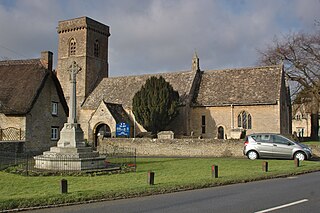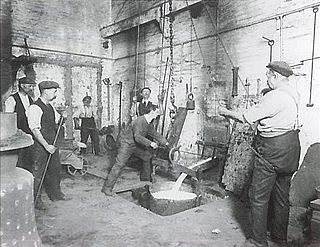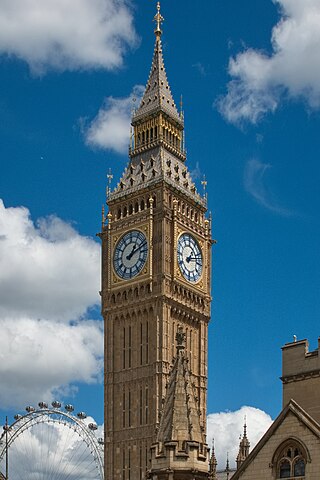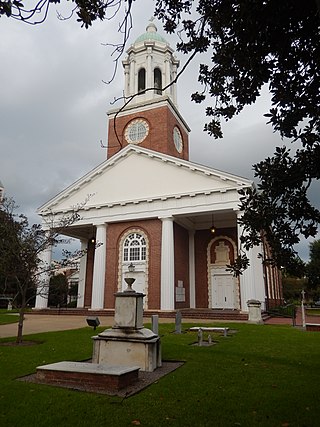Related Research Articles

The Whitechapel Bell Foundry was a business in the London Borough of Tower Hamlets. At the time of the closure of its Whitechapel premises, it was the oldest manufacturing company in Great Britain. The bell foundry primarily made church bells and their fittings and accessories, although it also provided single tolling bells, carillon bells and handbells. The foundry was notable for being the original manufacturer of the Liberty Bell, a famous symbol of American independence, and for re-casting Big Ben, which rings from the north clock tower at the Houses of Parliament in London.

Campanology is the scientific and musical study of bells. It encompasses the technology of bells – how they are founded, tuned and rung – as well as the history, methods, and traditions of bellringing as an art.

John Taylor Bell Foundry (Loughborough) Limited, trading as John Taylor & Co and commonly known as Taylor's Bell Foundry, Taylor's of Loughborough, or simply Taylor's, is the world's largest working bell foundry. It is located in Loughborough, in the Charnwood borough of Leicestershire, England. The business originated in the 14th century, and the Taylor family took over in 1784.

Lyminster is a village that is the main settlement of Lyminster and Crossbush civil parish, in the Arun District of West Sussex, England. It borders, to the south, Littlehampton, which has its town centre 2 miles (3 km) away.

Brize Norton is a village and civil parish 1 mile (1.6 km) east of Carterton in West Oxfordshire. The 2011 Census recorded the parish population as 938. The original part of RAF Brize Norton is in the parish.

Gillett & Johnston was a clockmaker and bell foundry based in Croydon, England from 1844 until 1957. Between 1844 and 1950, over 14,000 tower clocks were made at the works. The company's most successful and prominent period of activity as a bellfounder was in the 1920s and 1930s, when it was responsible for supplying many important bells and carillons for sites across Britain and around the world.

A chime or set of chimes is a carillon-like instrument, i.e. a pitched percussion instrument consisting of 22 or fewer bells. Chimes are primarily played with a keyboard, but can also be played with an Ellacombe apparatus. Chimes are often automated, in the past with mechanical drums connected to clocks and in the present with electronic action. Bellfounders often did not attempt to tune chime bells to the same precision as carillon bells. Chimes are defined as specifically having fewer than 23 bells to distinguish them from the carillon. American chimes usually have one to one and a half diatonic octaves. According to a recent count, there are over 1,300 existing chimes throughout the world. Almost all are in the Netherlands and the United States, with most of the remainder in Western European countries.

The Elizabeth Tower is the clock tower of the Palace of Westminster in London, England. It contains the Great Clock, a striking clock with five bells. The tower is nicknamed "Big Ben", a name which was originally applied only to the largest bell of the clock. The tower was officially called the Clock Tower until 2012, when it was renamed to mark the Diamond Jubilee of Elizabeth II.

Saint Paul's Church is a historic Episcopal church in downtown Augusta, Georgia, adjacent to Riverwalk Augusta. A member of the Episcopal Diocese of Georgia, Saint Paul's conducts its worship services using the 1979 Book of Common Prayer. The church, located on the corner of 6th and Reynolds Streets, is the oldest church congregation in Augusta. It was established in 1750 by the Church of England at the site of Fort Augusta. There have been five churches on the site. The current church building, which combines features of Federal architecture with those of the Georgian and Greek Revival styles, was designed by Henry Ten Eyck Wendell and dedicated in 1920. It can seat up to 600 people.
Rudhall of Gloucester was a family business of bell founders in the city of Gloucester, England, who between 1684 and 1835 cast more than 5,000 bells.

St. James Church located on Blake Street in Barrow-in-Furness, belongs to the Church of England's Diocese of Carlisle within the ecclesiastical Province of York. The present church building dates from the mid-19th century and is Grade II* listed.

South Newton is a village and civil parish about 4 miles (6.4 km) north-west of Salisbury in Wiltshire, England. Topologically it lies between chalk downs to the north-east, and downland with Grovely Wood to the south-west. The village straddles the A36 road and is on the left bank of the River Wylye, which defines much of the western boundary of the parish; the eastern boundary follows the A360 Salisbury-Devizes road.

St Peter and St Paul's Church, Aldeburgh is a Grade II* listed parish church in the Church of England in Aldeburgh, Suffolk.

St Mary's Church is a Grade I listed parish church in the Church of England in Mildenhall, Suffolk.

St Anne's Church, Whitstone is a Grade I listed parish church in the Church of England Diocese of Truro in Whitstone, Cornwall, England, UK.

St Mary Magdalene, Enfield, is a Church of England church in Enfield, London, dedicated to Jesus' companion, Mary Magdalene. The building is grade II* listed with Historic England.

The All Saints Cathedral Bells are heritage-listed church bells at All Saints Anglican Cathedral, Church Street, Bathurst, Bathurst Region, New South Wales, Australia. They were built from 1853 to 1855 by John Warner and Sons, Crescent Foundry of London, England. They were added to the New South Wales State Heritage Register on 10 September 2004.

Miles Graye was a dynasty of English bell-founders who had foundries in Colchester and Saffron Walden in Essex during the 17th-century. It is believed that the family cast over 415 bells, many of which remain today.
John Murphy was an Irish bellfounder. His foundry, which started making bells in 1843, cast bells for many churches in Ireland and elsewhere, including several rings of bells hung for change ringing.
Campanology is the scientific and musical study of bells. It encompasses the technology of bells – how they are cast, tuned, and rung – as well as the history, methods, and traditions of bellringing as an art. Articles related to campanology include:
References
- ↑ "Index - Warner". Towerbells.org. Retrieved 9 March 2016.
- ↑ "Cast bell. J Warner & Sons Ltd, London. 1892". Neill Robinson Blaxill. Archived from the original on 9 March 2016. Retrieved 9 March 2016.
- ↑ "John Warner and Sons - Graces Guide". www.gracesguide.co.uk. Retrieved 17 May 2019.
- ↑ "BIG BEN & the PALACE OF WESTMINSTER". Archived from the original on 16 October 2012. Retrieved 20 December 2012.
- ↑ "Dove Details". dove.cccbr.org.uk. Retrieved 17 May 2019.
- ↑ "Index to carillons and chimes by Warner". Tower Bells. Retrieved 30 July 2020.